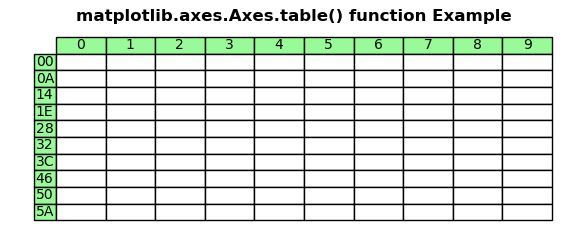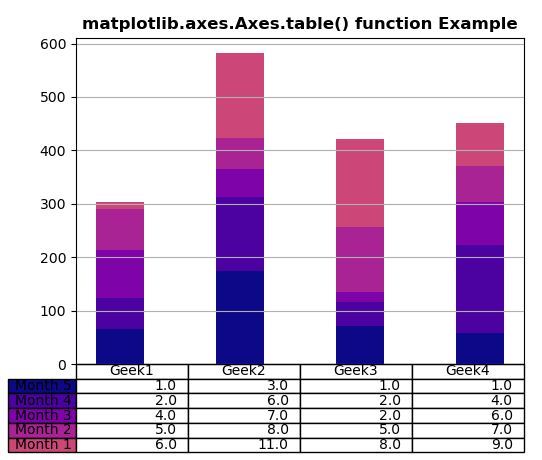Matplotlib是Python中的一个库,它是数字的-NumPy库的数学扩展。轴类包含大多数图形元素:Axis,Tick,Line2D,Text,Polygon等,并设置坐标系。 Axes实例通过callbacks属性支持回调。
matplotlib.axes.Axes.table()函数
matplotlib库的axiss模块中的Axes.table()函数还用于向Axes添加表。
用法: Axes.table(ax, cellText=None, cellColours=None, cellLoc=’right’, colWidths=None, rowLabels=None, rowColours=None, rowLoc=’left’, colLabels=None, colColours=None, colLoc=’center’, loc=’bottom’, bbox=None, edges=’closed’, **kwargs)
参数:此方法接受以下描述的参数:
- cellText:此参数包含要放置到表格单元格中的文本。
- cellColours:此参数是单元格的背景色。
- cellLoc:此参数是单元格中文本的对齐方式。
- colWidths:此参数是以轴为单位的列宽。
- rowLabels:此参数是行标题单元格的文本。
- rowColours:此参数是行标题单元格的颜色。
- rowLoc:此参数是行标题单元格的文本对齐方式。
- colLabels:此参数是列标题单元格的文本。
- colColours:此参数是列标题单元格的颜色。
- colLoc:此参数是列的文本对齐方式
标题单元格。 - Loc:此参数是单元相对于ax的位置。
- bbox:此参数是将表绘制到的边界框。
- edges:此参数是要用线条绘制的单元格边。
返回值:这将返回以下内容:
- 表:此方法返回创建的表。
以下示例说明了matplotlib.axes中的matplotlib.axes.Axes.table()函数:
范例1:
# Implementation of matplotlib function
import matplotlib.pyplot as plt
val1 = ["{:X}".format(i) for i in range(10)]
val2 = ["{:02X}".format(10 * i) for i in range(10)]
val3 = [["" for c in range(10)] for r in range(10)]
fig, ax = plt.subplots()
ax.set_axis_off()
table = ax.table(
cellText = val3,
rowLabels = val2,
colLabels = val1,
rowColours =["palegreen"] * 10,
colColours =["palegreen"] * 10,
cellLoc ='center',
loc ='upper left')
ax.set_title('matplotlib.axes.Axes.table() function Example',
fontweight ="bold")
plt.show()输出:

范例2:
# Implementation of matplotlib function
import numpy as np
import matplotlib.pyplot as plt
data = [[ 66, 174, 71, 58],
[ 58, 139, 45, 164],
[ 89, 52, 18, 81],
[ 78, 58, 123, 68],
[13, 159, 164, 80]]
val1 = ('Geek1', 'Geek2', 'Geek3', 'Geek4')
val2 = ['Month % d' % x for x in (5, 4, 3, 2, 1)]
val3 = np.arange(0, 2500, 500)
val4 = 1000
val5 = plt.cm.plasma(np.linspace(0, 0.5, len(val2)))
val6 = len(data)
val7 = np.arange(len(val1)) + 0.3
val8 = 0.4
val9 = np.zeros(len(val1))
lista = []
fig, ax = plt.subplots()
for row in range(val6):
ax.bar(val7, data[row], val8, bottom = val9,
color = val5[row])
val9 = val9 + data[row]
lista.append([(x // 50) for x in val9])
the_table = ax.table(cellText = lista,
rowLabels = val2,
rowColours = val5,
colLabels = val1,
loc ='bottom')
plt.subplots_adjust(left = 0.2, bottom = 0.2)
ax.set_xticks([])
ax.set_title('matplotlib.axes.Axes.table() function Example',
fontweight ="bold")
plt.grid()
plt.show()输出:

相关用法
注:本文由纯净天空筛选整理自SHUBHAMSINGH10大神的英文原创作品 Matplotlib.axes.Axes.table() in Python。非经特殊声明,原始代码版权归原作者所有,本译文未经允许或授权,请勿转载或复制。
